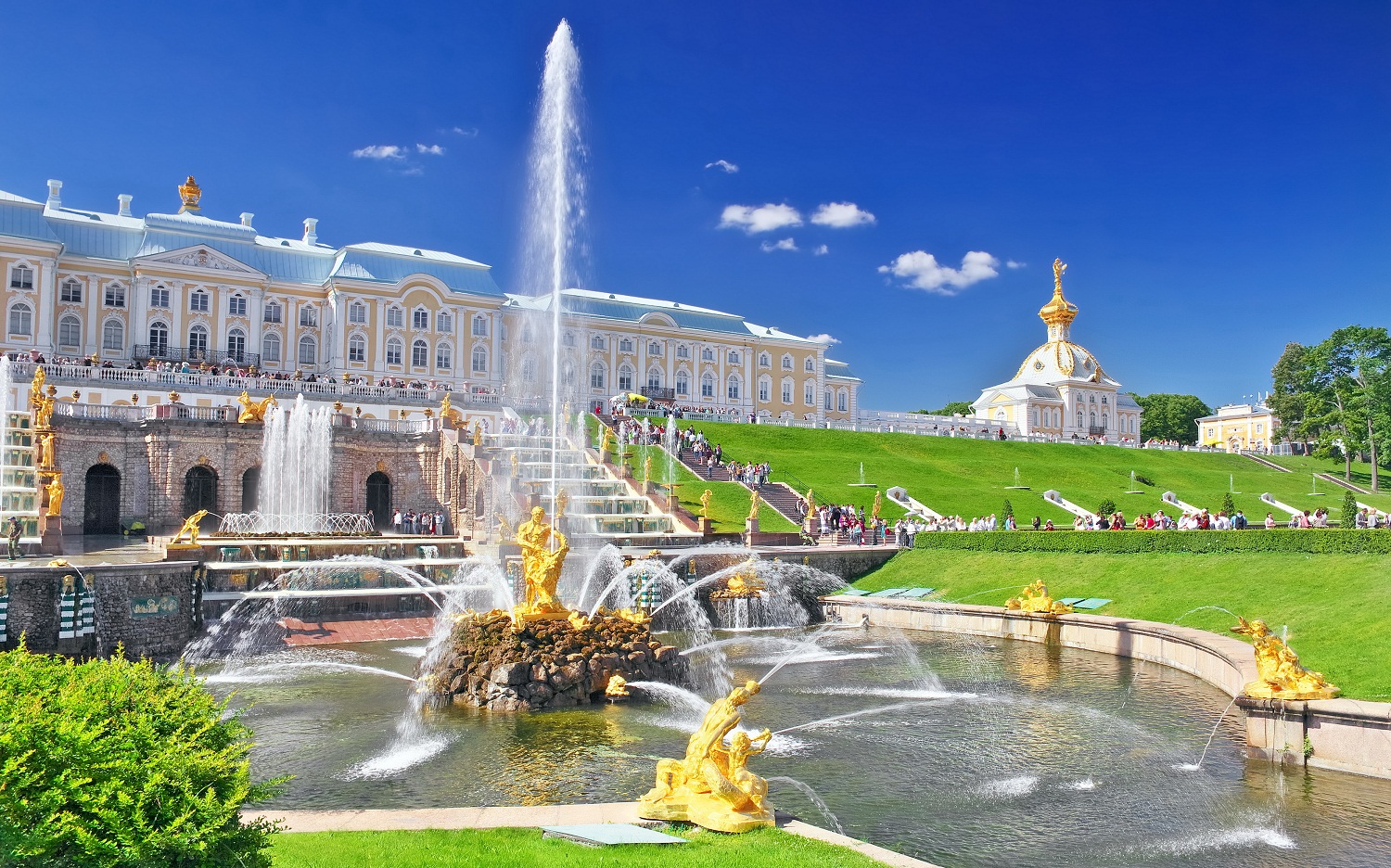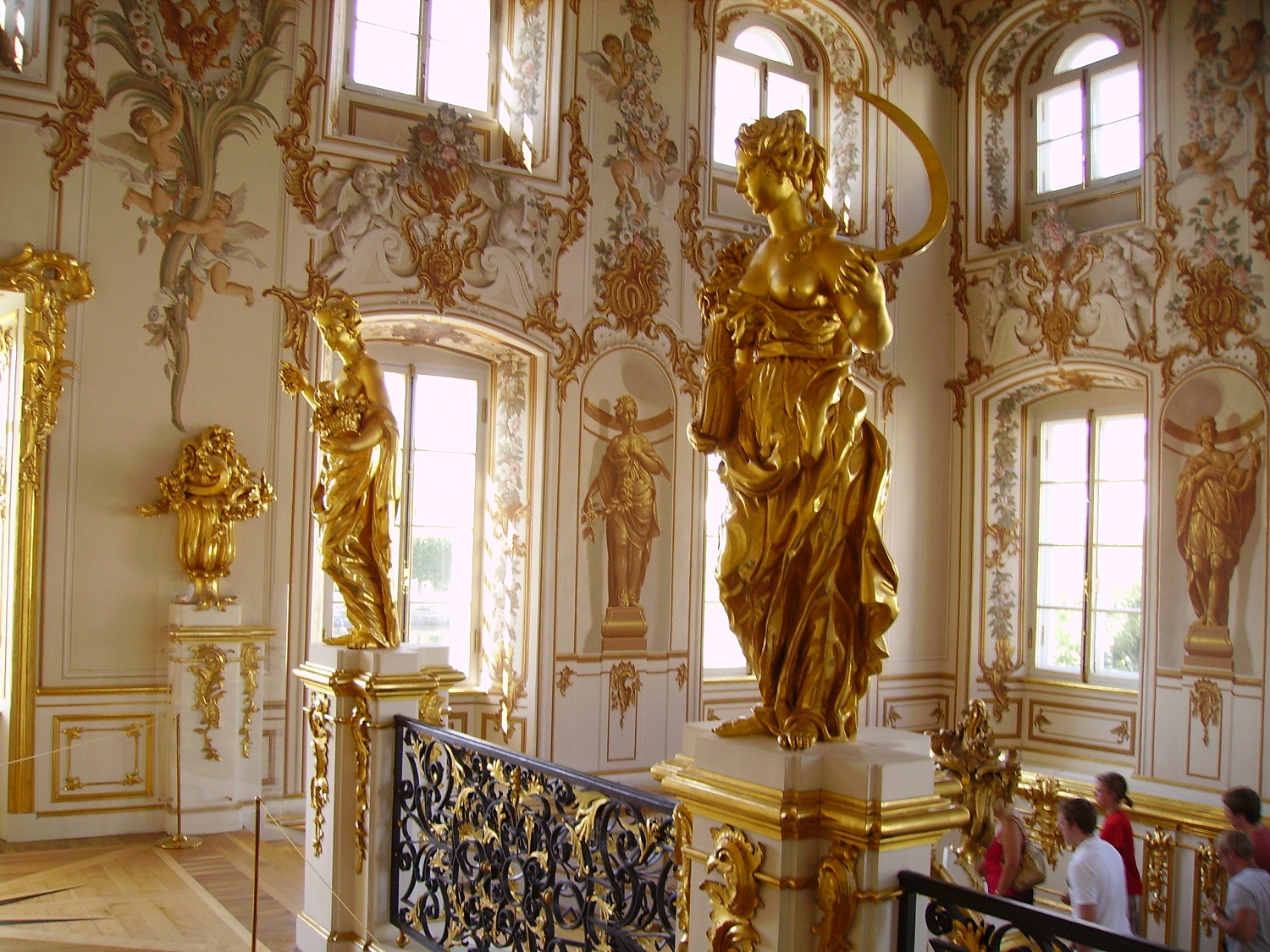The Peterhof Palace (Russian: Петерго́ф; IPA: [pʲɪtʲɪrˈɡof],Dutch for Peter's Court) is a series of palaces and gardens located in Saint Petersburg, Russia, laid out on the orders of Peter the Great. These Palaces and gardens are sometimes referred as the "Russian Versailles". The palace-ensemble along with the city center is recognized as a UNESCO World Heritage Site
In the time of Peter the Great, the sea floor just north of the Peterhof site and to the east toward St. Petersburg was too shallow for either commercial ships or warships. However, to the west of Peterhof, the sea floor dropped off to be deep enough for sea vessels. Accordingly, when Peter the Great decided to build St. Petersburg at the eastern end of the Gulf of Finland, he first captured the Kotlin Island clearly visible from the Peterhof site just to the northeast in the middle of the Gulf. At Kotlin Island he would build the commercial harbour for St. Petersburg as well as the Kronstadt fortifications across the 20 kilometres of shallow sea to provision and defend the Navy that he would build.
Peter the Great first mentions the Peterhof site in his journal in 1705, during the Great Northern War, as a good place to construct a landing for use in travelling to and from the island fortress of Kronstadt. And in 1714, Peter began construction of the Monplaisir ("my pleasure") Palace based on his own sketches of the palace that he wanted close to the shoreline. This was Peter's Summer Palace that he would use on his way coming and going from Europe through the harbour at Kronstadt. On the walls of this seacoast palace hung hundreds of paintings that Peter brought from Europe[3] and allowed to weather Russian winters and the dampness of the sea without heat. In the seaward corner of his Monplaisir Palace, Peter made his Maritime Study, from which he could see Kronstadt Island to the left and St. Petersburg to the right.[4] Later, he expanded his plans to include a vaster royal château of palaces and gardens further inland, on the model of Versailles. The initial design of the palace and its garden was done by the French architect Jean-Baptiste Le Blond.[5] Each of the tsars after Peter expanded on the inland palaces and gardens of Peterhof, but the major contributions by Peter the Great were completed by 1725. Peter had also entertained plans of a similar palace at Strelna, a short way to the east, but these plans were abandoned.
Peterhof originally in the early 1700s appeared quite different from today. Many of the fountains had not yet been installed. The entire Alexandrine Park and Upper Gardens didn't exist. (The latter was used to grow vegetables, and its ponds, then numbering only three, for fish.) The Samson Fountain and its massive pedestal had not yet been installed in the Sea Channel, and the channel itself was used as a grand marine entrance into the complex.
Perhaps the most important change augmenting Peter's design was the elevation of the Grand Palace to central status and prominence. The Grand Palace was originally called simply 'Upper', and was hardly larger than any of the other structures of the complex. The addition of wings, undertaken between 1745 and 1755, was one of the many projects commissioned from the Italian architect Bartolomeo Rastrelli by Elizabeth of Russia. Likewise, the Grand Cascade was more sparsely decorated when initially built. The augmentation of Peterhof's original fountains and the addition of new ones continued well into the 19th century.
Peterhof, like Tsarskoye Selo, was captured by German troops in 1941 and held until 1944. In the few months that elapsed between the outbreak of war in the west and the appearance of the German Army, employees were only able to save a portion of the treasures of the palaces and fountains. An attempt was made to dismantle and bury the fountain sculptures, but three quarters, including all of the largest ones, remained in place. The occupying forces of the German Army largely destroyed[6] Peterhof. Many of the fountains were destroyed, and the palace was partially exploded and left to burn. Restoration work began almost immediately after the end of the war and continues to this day.
The name was changed to "Petrodvorets" ("Peter's Palace") in 1944 as a result of wartime anti-German sentiment and propaganda, but the original name was restored in 1997 by the post-Soviet government of Russia. In 2003, Saint Petersburg celebrated its 300th anniversary. As a result, much of the building and statuary in Peterhof has been restored and new gilt-work abounds.
The "purpose" of Peterhof was as a celebration and claim to access to the Baltic (while simultaneously, Peter the Great was also expanding on the Black Sea littoral). Thus Peterhof commemorates the imperial expansion (and modernization of Russia). Inside the Peterhof there are many paintings of sea battles by the famous Ivan Aivazovsky.











